Abstract
In this study, we assess the diamond exploration potential of the northern East European Platform based on aeromagnetic survey results and the morphologic and geochemical analysis of 1513 grains of kimberlite indicator minerals (KIMs), such as purple pyrope garnet, olivine, and Cr-diopside. These minerals were recovered from samples collected from modern river and stream sediments in four areas located in the north-eastern (within the Arkhangelsk Diamondiferous Province) and south-western (hundreds of kilometers outside of the Arkhangelsk Diamondiferous Province) parts of the Arkhangelsk region in the European part of Russia. All the studied areas are located within ancient cratons, including the Kola, Karelian, and Shenkursk cratons. Based on the major element compositions of the KIMs and thermobarometric calculations, this study confirms that the lithospheric mantle beneath the studied areas is suitable for the formation and preservation of diamonds. The high percentage of KIMs with primary magmatic grain surface morphologies is evidence of the presence of local kimberlite sources within all of the studied areas. The significant amount of diamond-associated KIMs indicates that the potential sources are diamondiferous. Hence, the results suggest that the studied areas can be recommended for further diamond prospecting activity with a high probability of discovering new diamondiferous kimberlites.
1. Introduction
There are three main ages of kimberlite magmatism in the northern East European Platform: first, the Paleoproterozoic Kimozero (1.92 Ga) and Kostomuksha (1.2 Ga) kimberlites of central Karelia in Russia [1] and the Kuhmo-Lentiira (1.2 Ga) kimberlites in Finland [2]; second, the Neoproterozoic Kuusamo (757 ± 2 Ma) and Kaavi-Kuopio (626–589 Ma) kimberlites of eastern Finland [3,4,5]; and, third, the Devonian–upper Carboniferous kimberlites of the Terskii Coast (380–360 Ma; [6]), Timan Ridge [7] and Arkhangelsk Diamondiferous Province (ADP, 390–340 Ma; [8]) in the European part of Russia (Figure 1A,B). Most kimberlites contain low concentrations of diamonds and are currently economically unattractive. Within the ADP, only the kimberlites of the Lomonosov and Grib pipes are economically diamondiferous and are the main diamond deposits within the East European Platform. However, finds of diamonds are widespread within the territories of the northern East European Platform (Figure 1A). Moreover, several industrial diamond placers with unknown sources have been identified in intermediate deposits within the Middle Timan Ridge and modern alluvial sediments in the South Ural areas (Figure 1A). Numerous finds of diamonds and KIMs, as well as kimberlite fragments, have been identified within the Arkhangelsk region outside of the ADP, indicating the possibility of discovering new kimberlite pipes.
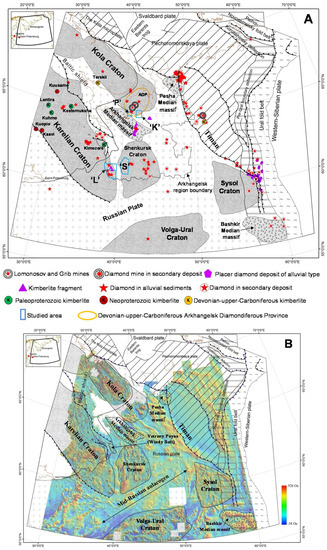
Figure 1.
Location of of the northern East European Platform. (A) Tectonic terranes; (B) map of anomalous magnetic field ΔT.
Here, we provide a new interpretation and visualization of geophysical data obtained from an aeromagnetic survey of the northern part of the East European Platform and present morphologic and geochemical results for kimberlite indicator minerals (KIMs) obtained from samples collected from modern river and stream sediments in the north-eastern (within the ADP) and south-western (hundreds of kilometers outside of the ADP) parts of the Arkhangelsk region. The data provide an opportunity to obtain insights into the diamond exploration potential of the northern East European Platform, particularly within the areas of the Arkhangelsk region, and to identify more prospecting localities.
2. Geological Background
Russia is a major diamond producer and is responsible for approximately 30% of the world’s diamond output each year [9]. Most of its diamond mines are located in the Siberian Craton within the boundaries of the semi-autonomous Sakha Republic (Yakutia). The Arkhangelsk region (with an area of ~590,000 km2)—particularly, the ADP (~19,000 km2) located in the northern portion of the European part of Russia—is the other major economically diamondiferous area.
The Devonian–upper Carboniferous ADP is a complex region of ultrabasic and basic magmatism dominated by kimberlite magmatism [10] and includes several magmatic fields: the Zolotitsa kimberlite field; the Kepino and the Verhotina fields of kimberlites and olivine melilitites; the Turiyno basaltic field; the Izhmozero field of olivine melilitite and picrite; and the Mela field of kimberlite and carbonatite [11,12] (Figure 2). To date, ~100 magmatic bodies are known within the ADP, including ~70 kimberlite pipes [11]. The kimberlites of the Zolotitsa field are compositionally similar to the South African Group II kimberlites, whereas the kimberlites of the Kepino, Verhotina, and Mela fields are enriched in Fe and Ti and compositionally similar to Group I kimberlites [13]. Six of the Zolotitsa kimberlites (i.e., the Lomonosov mine) and the V. Grib kimberlite pipe are rich in diamonds and economically exploitable. Two kimberlite pipes (Arkhangelskaya and Karpinskogo-1) of the Lomonosov deposit (operated by Alrosa, located in Arkhangelsk city, Russia) and the V. Grib pipe (operated by Otkritie Holding, located in Arkhangelsk city, Russia) are currently being mined [9]. The other ADP kimberlites, including four kimberlite pipes in the Zolotitsa field and other Fe–Ti-rich kimberlites, are diamond poor and uneconomic.
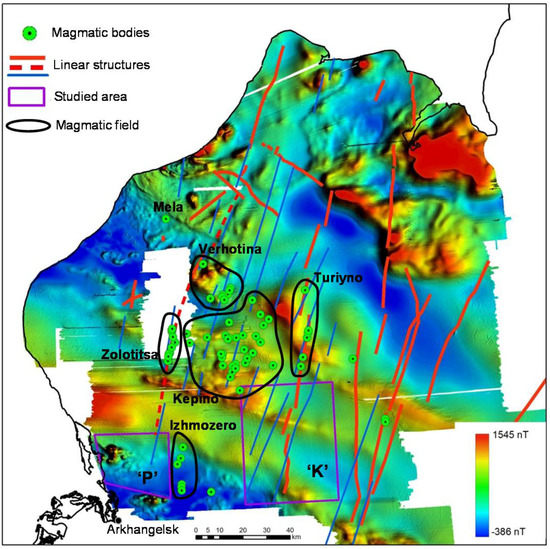
Figure 2.
Map of anomalous magnetic field ΔT for the Arkhangelsk Diamondiferous Province (ADP). Magmatic field from [11].
The Devonian–upper Carboniferous ADP magmatic rocks are present in the form of pipes, dykes, sills, and various combinations, and they intrude into Vendian sedimentary rocks (sandstones, siltstones, and mudstones) and are covered by middle Carboniferous to Permian terrigenous and carbonate rocks and unconsolidated Cenozoic sediments. The total thickness of the sedimentary cover varies, with a minimum thickness of 30–50 m in the western ADP and a maximum depth of 150–200 m in the eastern ADP. The structure of almost all of the magmatic bodies includes a crater that consists of various volcaniclastic, volcaniclastic–sedimentary, and sedimentary rocks, with abundant xenoliths of the terrigenous host rocks. The depth of the crater varies from 20–40 m to 200–300 m, with an average value of 100–150 m. Rare magmatic bodies have no crater facies (e.g., the pipes in the Izhmozero field and the Pomorskaya and Karpinskogo-2 pipes in the Zolotitsa field). Magmatic pipes in the central ADP contain abundant terrigenous and carbonate xenoliths of Cambrian and Ordovician ages, indicating the presence of sediments of these ages during the Devonian–late Carboniferous magmatism in the region and their subsequent erosion.
3. The Main Principles of Diamond Exploration
The geophysical and indicator mineral methods are the main tools for diamond exploration. Among the various geophysical methods, including seismic, gravity, and electromagnetic techniques, aeromagnetic survey is the main geophysical tool for diamond exploration. Low-resolution (1:200,000) aeromagnetic surveys covering large areas are used to identify major geological structures that are potentially related to kimberlite magmatism. The results of more-detailed medium-resolution (1:50,000–1:25,000) aeromagnetic surveys, together with the indicator mineral method, are used to identify prospecting areas that could host diamond-bearing kimberlites. High-resolution (1:10,000–1:5000) aeromagnetic surveys are used to identify local “geophysical” or “pipe-like” anomalies that could be potential kimberlites and that should be investigated further by drilling.
The indicator mineral method involves sampling surface materials (soils, stream sediments, till), recovering heavy minerals from the samples, and extracting and identifying possible KIMs. The most important indicator minerals for kimberlite exploration are pyrope, chromite, Mg-rich ilmenite (i.e., picroilmenite), Cr-diopside, and Mg-olivine (i.e., forsterite). Major and minor element analysis provides the ability to precisely identify KIMs and to determine the diamond potential of a source, as well as providing an indication of the composition of the underlying mantle and its suitability for the formation and preservation of diamonds [14].
The morphologic analysis of KIMs, i.e., characterization of the grains (e.g., size, surface texture, surface coating, and angularity), is a powerful tool for determining (1) the proximity of these KIMs to their primary source, i.e., whether they have experienced short- or long-distance transport; (2) the kind of transport, i.e., alluvial or secondary/intermediate deposits; (3) the extent of mechanical abrasion; and (4) the degree of intactness, i.e., whether they have primary magmatic features without evidence of mechanical abrasion. Combining the results obtained from the geophysical and indicator mineral methods and considering the geomorphic, stratigraphic, tectonic, and geological history of the studied province provide the ability to locate potential areas for diamond exploration.
4. Geophysical Data
The initial materials for this study include 650 maps (scale of 1:200,000) of the anomalous magnetic field (ΔT) in the northern territories of the European part of Russia from the border with Finland to the Ural Mountains and from the northern Baltic Shield to 56° north latitude. The maps were published on the basis of aeromagnetic surveys performed in the 1950s–1990s. All maps were digitized, vectorized, and consolidated into one project. The processing of the materials was performed using the software package “Proex-geology”, which is an automated system for the complex processing of geological and geophysical data for prospecting of deposits and was developed by Proex Service Ltd., located in Arkhangelsk city, Russia (Certificate of Rospatent No. 2004610060). The result is presented in Figure 1B. A number of large segments of the Earth’s crust are clearly identified in the geomagnetic fields, including cratons (Kola, Karelia, Shenkursk, Volga-Ural, and Sysol), median massifs (Arkhangelsk, Pesha, and Bashkir), and large linear structures (e.g., Vetreny Poyas (Windy Belt), Timan, and the Mid-Russian aulacogen). Notably, the Shenkursk, Volga-Ural, and Sysol cratons, as well as the Pesha, and Bashkir median massifs, have not been previously distinguished. The interpretation of the aeromagnetic data and the gravity and seismic data indicates that the ADP occurs within the southern part of the Kola Craton (or Kola Continent, after [15]), which is covered by platform sediments with no exposed basement crystalline rocks.
As shown in Figure 1, localization of known kimberlite pipes, as well as finds of diamonds, KIMs, and kimberlite fragments, occurs within the ancient cratons and median massifs in most cases. Therefore, the Shenkursk Craton, Arkhangelsk median massif, and the south-eastern part of the Karelian Craton are expected to be the most promising areas for future prospecting, thereby clarifying the possibilities for new kimberlite pipe discoveries. This hypothesis is corroborated by the numerous finds of diamonds, KIMs, and kimberlite fragments within these areas and the lack of closely located magmatic pipes. However, the southern part of the ADP also can be regarded as a potential new kimberlite discovery area based on geophysical evidence. As shown in Figure 2, numerous submeridional linear structures, which in most cases control the location of magmatic pipes, are present in all portions of the ADP. The southern parts of the linear structures, controlling the Lomonosov diamond deposit and the Turiyno basaltic pipes, could hold potential for the discovery of new kimberlite pipes.
5. Sample Location, Collection, and Methods
The four studied areas (abbreviated L, S, P, and K) are shown in Figure 1A and . The ‘L’ and ‘S’ areas are located in the southern part of the Arkhangelsk region, hundreds of kilometers outside of the ADP. The ‘L’ area (7284 km2) is situated within the SE part of the Karelian Craton on the border with the Republic of Karelia. The ‘S’ area (5673 km2) is situated in the western part of the Shenkursk Craton. The ‘P’ (716 km2) and ‘K’ (1978 km2) areas are located on the southern border of the ADP.
The following numbers of samples were collected from modern river and stream sediments in the studied areas: 1711 samples from the ‘L’ area; 2938 samples from the ‘S’ area; 904 samples from the ‘P’ area; and 788 samples from the ‘K’ area. A total of 6341 samples were collected during three years of field seasons from modern river and stream sediments. Unpanned wet sample weights typically ranged from 46 to 57 kg. Each sample was processed for heavy minerals on site using the panning method. Then, the resultant concentrates were processed via magnetic and heavy liquid separation in the “Bronnitskaya Geological and Geochemical Expedition” laboratory at the Institute of Mineralogy, Geochemistry and Crystallochemistry of Rare Elements (Moscow, Russia). Using a binocular microscope, the mineral concentrates were picked for KIMs (specifically, pyrope, olivine, and Cr-diopside). In total, 3500 mineral grains were picked and subjected to morphologic study and microprobe analysis. The study of KIM morphology was conducted using a MIRA 3 LMU (Tescan Ltd.) SEM equipped with an INCA Energy 450 XMax-80 EDS (Oxford Instruments Ltd.) at the Sobolev Institute of Geology and Mineralogy, Siberian Branch Russian Academy of Sciences (IGM SB RAS) Analytical Centre for Multi-element and Isotope Research (Novosibirsk, Russia). Then, the minerals were mounted in epoxy, polished, and analyzed to determine the major element compositions and Ni concentrations in pyrope. The major element compositions of the minerals were determined by electron probe microanalysis (EPMA) of polished sections using a JXA-8100 microanalyzer (JEOL, Tokyo, Japan) at the IGM SB RAS Analytical Centre for Multi-Element and Isotope Research (Novosibirsk, Russia). The operating conditions included an accelerating voltage of 20 kV, a beam current of 50 nA, and a spot size of 1 µm. Natural minerals from the IGM SB RAS reference collection were used as standards and analytical results were corrected using the ZAF correction program. The relative standard deviation did not exceed 1.5%. The detailed operation information is given in [16]. Ni concentrations in pyrope were analyzed with an accelerating voltage of 25 kV, a beam current of 300 nA, and a count time of 400 s for peaks and background [17]. Based on the microprobe analysis results, 1513 grains were identified as potential KIMs.
6. Results
6.1. Morphologic Study of KIMs
Three main types of surface morphologies were identified in the pyrope grains: primary magmatic (or pristine); chemically abraded; and mechanically abraded/modified (i.e., transported). The same morphologies, excluding the chemically abraded type, were identified in the olivine and Cr-diopside grains. The chemically abraded morphology is extremely rare due to the low degree of stability under chemical/hypergene conditions (i.e., in secondary deposits). Generally, the chemical/hypergene stability of KIMs increases with the following sequence: olivine, Cr-diopside, pyrope, picroilmenite, chromite, diamond [18]. As a result, olivine and Cr-diopside are practically absent in secondary deposits.
The primary magmatic morphology is recognized by pyramidal shingle-like relief or visible microrelief formed by minute “drops” and “tubercles” in SEM images (Figure 3A–F). Such minerals have been transported very short distances and are generally found within kimberlite eluvium and nearby aureoles [18,19,20]. The preservation of mineral intergrowths, kelyphitic rims, and inclusions is further evidence of the extremely limited transport distance and absence of mechanical abrasion of the grains. Therefore, locating grains with this morphology is extremely important for diamond exploration because this morphology is indicative of a local origin and nearby kimberlite pipe.
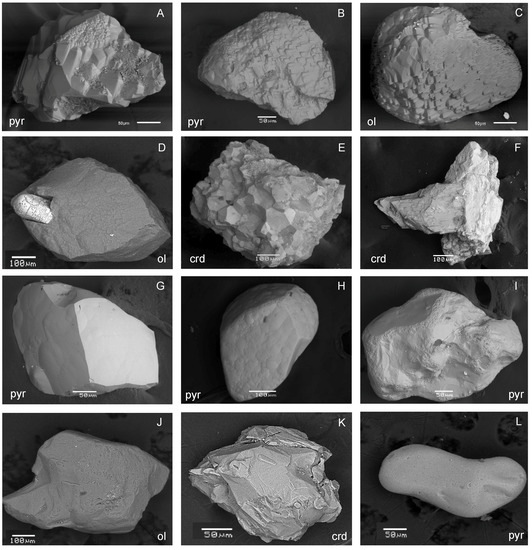
Figure 3.
SEM images of Kimberlite Indicator Mineral (KIM) grains. (A–F) primary magmatic surface; (G,H) chemically abraded surface; (I–L) mechanically abraded surface. Pyr, pyrope; ol, olivine; crd, Cr-diopside.
The chemically abraded pyrope morphology is recognized by distinctive “drop-like” relief during the first stages of the chemical corrosion process and the formation of cuboid grains during the final stages (Figure 3G,H). These pyrope grains could have formed only in a laterite-type weathering crust in ancient secondary deposits, formed after mineral transportation from the original point of formation (kimberlite) further to another point of deposition (sediments) [18]. The discovery of this morphology may be indicative of a potential diamond deposit in the form of an ancient placer type and may provide evidence on the age of the source. The latter is based on the fact that, within the Arkhangelsk region, pyrope grains with the chemically abraded type morphology were found in sedimentary rocks with ages ranging from the Ordovician-Silurian boundary to the Permian-Triassic boundary, thus limiting the age of the magmatic source.
The mechanically abraded KIM surface morphology is distinguished by smooth, uniform subrounded to rounded shapes (Figure 3I–L). Generally, the degree of mechanical abrasion can be divided into 5 categories (0 to 5) in the following way: 0–1: no evidence/low degree of abrasion, equivalent to the primary magmatic morphology; 2–3: moderate degree of abrasion (Figure 3I–K); and 4–5: strong degree of abrasion (Figure 3L). The interpretation of the degree of mechanical abrasion in KIMs depends on many factors (e.g., the initial size and shape of the grain and the type of abrasive material, [21]). The two main factors are listed below. The first factor is the abrasive stability of KIMs that increase in the following order: Cr-diopside, picroilmenite, olivine, pyrope, chromite, diamond. For example, the presence of pyrope grains with strongly mechanically abraded surfaces in the sample excludes the possibility of the presence of Cr-diopside, picroilmenite, and olivine from the same source. Under equal conditions of mechanical abrasion (e.g., distance, duration, and type of abrasive material), Cr-diopside, picroilmenite, and olivine break down more readily than pyrope. The second factor is the nature of the environment (i.e., continental or coastal marine) of halo formation. Heavily mechanically abraded surfaces of KIMs are not always evidence of long-distance transport and can instead be linked to mechanical abrasion during reciprocating motion (i.e., in a coastal marine environment) in areas even proximal to the source. The degree of mechanical abrasion clearly depends on the transport distance of KIMs from their origin in the case of alluvial transport (i.e., in a continental environment). Cr-diopside and olivine are generally assumed to not be transported significant distances from their source, whereas picroilmenite, pyrope, and chromite may be dispersed considerable distances from their point of origin [14]. Thus, the mechanically abraded morphology of KIMs can be interpreted in different ways, and the correctness of the interpretation depends on combining several factors, including the physicochemical characteristics of the KIMs, the geomorphology of the area, and paleogeographic reconstructions. Despite the problematic issues associated with identifying the source location, the study of KIMs with mechanically abraded surfaces cannot be ignored during diamond exploration because their presence in samples indicates the existence of a source within the area.
The percentages of KIMs with different grain morphologies within the four studied areas are presented in Table 1. As shown in Table 1, the percentage of KIMs with primary magmatic morphologies is extremely high for olivine (92–100%) and relatively high for pyrope (17–39%) in the samples from all areas. Pyrope with the chemically abraded morphology is common in the ‘P’ area samples (26%), rare in the ‘K’ area samples (8%), and approximately the same in the ‘L’ and ‘S’ area samples (14% and 18%, respectively). Cr-diopside with the primary magmatic morphology is relatively abundant in the southern area (‘L’ and ‘S’) samples (48% and 40%, respectively) and rare in the northern area (‘K’ and ‘P’) samples (12%). Nevertheless, the abundance of KIMs with primary magmatic morphologies, suggesting local derivation, is high enough to reasonably confirm the probable existence of unknown magmatic sources (possibly kimberlites) within or near the studied areas.

Table 1.
The percentage (%) of KIM surface morphologies in the samples from the studied areas. P, primary magmatic; C, chemically abraded; M, mechanically abraded; N, number of grains analyzed.
6.2. Interpretation of KIM Microprobe Analyses
The major element compositions of the KIMs are presented in Supplementary Materials.
6.2.1. Pyrope
Pyrope is considered to be the most important KIM, and its chemistry is one of the best tools used in diamond exploration for identifying kimberlites and determining their potential to host diamonds [22,23,24,25,26,27].
The Cr2O3–CaO discrimination diagram [27] was used for pyrope classification. The results are presented in Figure 4A–D and Table 2. Lherzolitic pyrope (G9) predominates over other garnet varieties in the samples from all the areas, proportionally increasing in the following sequence: K (73%) < S (78%) < P and L (81%). The percentage of harzburgitic pyrope (G10) varies within the range of 6–17% and is highest in the ‘K’ area samples and lowest in the ‘S’ area samples. The percentage of pyrope with a diamond association (DA, i.e., high-chromium G9 and G10 pyrope [28,29,30]) is relatively high in the ‘K’ area samples (30%), moderate in the ‘L’ and ‘P’ area samples (21% and 17%, respectively), and relatively low in the ‘S’ area samples (11%). CaO-rich wehrlitic pyrope (G12) is present in samples from all areas and varies within the range of 2–10%. Only a small percentage of the pyrope is classified as Ti-rich Cr-poor megacrysts (2–6%). Pyrope of pyroxenitic paragenesis (1–3%) is observed only in the ‘S’ area samples. Single pyrope grains that are genetically linked to deformed peridotites [31], i.e., those with high-Ti and high-Cr compositions, are present in the samples from all areas (see Supplementary Materials). On the Cr2O3–Mg# diagram (Figure 4E), all the grains plot in the fields of the lherzolitic pyrope from the ADP diamondiferous kimberlites and the diamond-associated pyrope from the V. Grib kimberlite pipe [30].
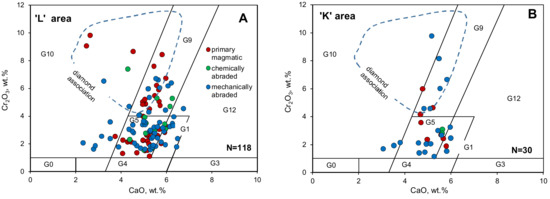
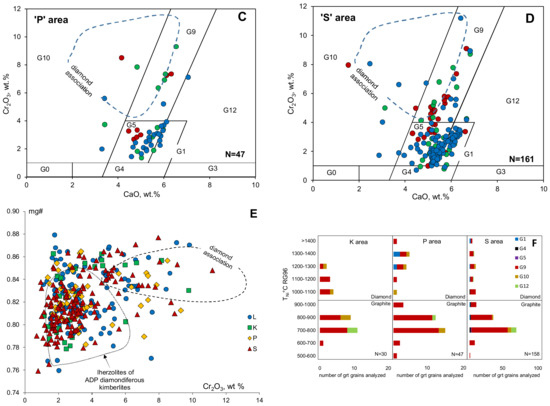
Figure 4.
Chemical composition of pyrope. (A–D) CaO–Cr2O3 diagram [27]. Diamond association, high-chromium G9 and G10 pyrope [28,29,30]; N, number of grains analyzed. (E) Mg# vs. Cr2O3, lherzolites of the ADP diamondiferous kimberlites [11,30,35,37,38,43]. (F) Distribution of TNi [32] for the pyrope of ‘K’, ‘P’, and ‘S’ areas. Graphite–diamond transition drawn based on the Cpx-derived geotherm.

Table 2.
The percentage (%) of pyrope paragenesis [25] in the samples from the studied areas. DA, diamond association [27]. N, number of grains analyzed.
The TNi [32] histogram for pyrope is presented in Figure 4F. The highest temperature peak is within the range of 1000–1200 °C for the ‘K’ and ‘S’ areas and 1200–1400 °C for the ‘P’ area. Based on the T parameter values and the graphite–diamond transition boundary (obtained from the Cr-diopside geotherm; see below), the percentage of pyrope from the diamond stability field is 25–30% (‘K’, 30%; ‘P’, 26%; ‘S’, 28%).
6.2.2. Olivine
Olivine is the most common rock-forming mineral in kimberlites. However, it is also present in other lithologies. Despite applying the geochemical criteria for KIM identification, a portion of the olivine in the studied samples is surely or likely not related to kimberlites. Nevertheless, the occurrence of kimberlite-related olivine with other KIMs in the samples can play an important diagnostic role in kimberlite identification.
The Cr2O3/NiO and Cr2O3/Mg# diagrams (Figure 5A,B) were used to determine whether the olivine is derived from kimberlites. Most of the olivine (55–70%) from all the areas has Mg# values (magnesium numbers = 100Mg/(Mg + Fe)) that are greater than 95, which is not typical for kimberlitic olivine. To our knowledge, extremely Mg-rich olivine (Mg# 96) has been identified in association with kimberlites only in the form of several groundmass olivine grains in the Udachnaya kimberlites [33]. Olivine from the ADP kimberlites, mantle peridotites, and diamonds is characterized by Mg# values between 88 and 94, notable trace amounts of NiO, and Cr2O3 contents of >0.01 wt % (see Figure 5A–C; [11,34,35,36,37,38,39]). Therefore, olivine with extremely Mg-rich composition is ruled out as being potentially kimberlitic in the current stage of this study. The percentage of kimberlite-related olivine varies within the range of 15–45% and is highest in the ‘K’ area samples and lowest in the ‘L’, ‘S’, and ‘P’ area samples. The proportion of diamond-associated olivine [40] is 19–26% of kimberlitic olivine in the ‘L’, ‘K’, and ‘P area samples. None of the olivine grains from the ‘S’ area samples match the compositional field of diamond-associated olivine.
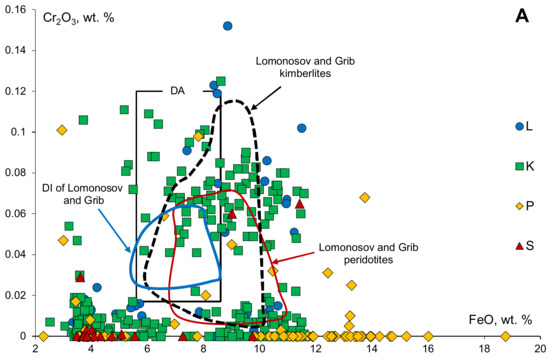
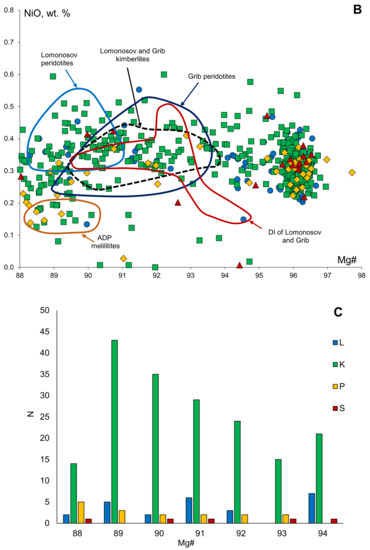
Figure 5.
Major element composition of olivine. (A) Cr2O3–FeO diagram; (B) NiO–Mg# diagram; (C) distribution of Mg#, N, number of grains analyzed. DA, diamond association [40], Lomonosov and Grib kimberlites and peridotites [11,35,37,38,39], DI (inclusion in diamonds) from the Lomonosov and Grib [11,36], ADP melilitites [11].
6.2.3. Cr-diopside
Similar to olivine, Cr-diopside is a less preserved KIM than garnet but, in association with other KIMs in the samples, can provide important information on kimberlite location and diamond potential. In addition, Cr-diopside is a very useful tool for evaluating the thermal state of the lithosphere and the depth at which the grains originated, as well as the lower boundary of the lithospheric mantle and the width of the “diamond window”.
All the Cr-diopside plots within the kimberlite indicator field in the [41] Wo–En–Fs diagram. In the Cr2O3–Al2O3 discrimination diagram [42], 16% of the grains do not match the “on-craton” garnet–peridotite field and, therefore, are ruled out as potentially kimberlitic Cr-diopside (Figure 6A). In the Cr2O3–CaO diagram (Figure 6B), all the potentially kimberlitic Cr-diopside plots within the field of Cr-diopside from the Lomonosov and Grib peridotites and kimberlites [11,35,37,38,43] and the field representative of Cr-diopside inclusions in diamonds [44], with the exception of 20 grains (Figure 6B). In total, the percentage of kimberlitic Cr-diopside is relatively high in samples from all of the areas and varies in the range of 64–78%.
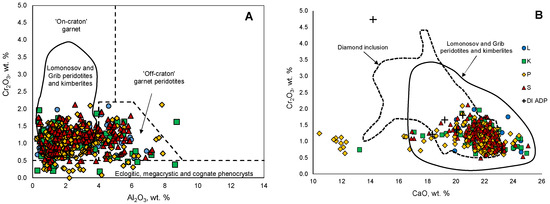
Figure 6.
Major element composition of Cr-diopside. (A) Cr2O3–Al2O3 diagram [38]; (B) Cr2O3–CaO diagram. Lomonosov and Grib kimberlites and peridotites [11,35,37,38,39], diamond inclusion field [44], DI (inclusion in diamonds) from the ADP [11].
The results of single-clinopyroxene thermobarometry [45] are presented in Figure 7A–D. The majority of the P-T points for Cr-diopside from the ‘L’, ‘K’, and ‘S’ areas plot between the heat fluxes of 35 and 40 mW/m2 [46], similar to the ADP mantle samples [35,37,38,43]. The P-T points for Cr-diopside from the ‘P’ area clearly differ from those of the other areas and plot along the hot cratonic heat flux of 45 mW/m2. Based on the Cr-diopside thermobarometry, all the areas show continuous mantle sampling down to 160–180 km.

Figure 7.
P-T data [45] for Cr-diopside. N, total grains analyzed. Reference geotherms [46]. (A) ‘L’ area; (B) ‘K’ area; (C) ‘P’ area; (D) ‘S’ area.
7. Discussion
The finds of KIMs, diamonds, and kimberlite fragments are widespread within the northern territories of the East European Platform, likely indicating multiple sources, possibly of different ages. Almost all of these finds are within ancient cratons and median massif areas, which therefore can be regarded as high-priority locations for diamond prospecting activity. Potentially undiscovered diamondiferous kimberlite clusters could also reveal new magmatic events aside from those already recognized (Paleoproterozoic, Neoproterozoic, and Devonian–upper Carboniferous periods) in this region [47].
The southern areas of the Arkhangelsk region (‘L’ and ‘S’ areas) are of particular interest due to anomalously high KIM contents, their location within ancient cratons, and the lack of any known nearby magmatic bodies, including kimberlites. Generally, this region is poorly studied, making the results obtained from this study important for (1) understanding the possible presence of kimberlites and related rocks; (2) evaluating the composition, thermal state, and depth of the lithospheric mantle; and (3) testing the suitability of the underlying mantle to produce and preserve diamonds.
The kimberlites nearest the ‘L’ and ‘S’ areas, i.e., the Kimozero kimberlites, cannot be regarded as a possible source for the KIMs because of the almost complete absence of pyrope and Cr-diopside in the Kimozero kimberlite and the limitations imposed by the Onega Lake area on the Kimozero KIM distribution [48]. Also, KIMs obtained from the ‘L’ and ‘S’ area samples cannot have the same source due to geomorphologic differences. Therefore, several kimberlite sources are expected to exist within the two areas. The significant percentage (14–18%) of chemically abraded pyrope in the ‘L’ and ‘S’ area samples indicates that some intermediate deposits were eroded along with primary kimberlite sources, indicating the presence of kimberlite sources with different ages in the region. Additionally, the high proportions of olivine and Cr-diopside derived from non-kimberlitic mantle lithologies with primary magmatic morphologies may indicate the presence of several mafic–ultramafic bodies. The possible presence of kimberlites and related rocks in this region makes it potentially similar to the ADP.
Based on the pyrope composition data, the lithospheric mantle beneath the ‘L’ and ‘S’ areas is mostly composed of the garnet lherzolites with a minority of garnet harzburgites, dunites, and wehrlites. Cr-diopside thermobarometry delineated a mostly cold cratonic geotherm between 35 and 40 mW/m2, similar to the ADP lithospheric mantle, and the diamond stability field is encountered at temperatures of 800–1000 °C. The extrapolation of pyrope TNi data to the Cr-diopside-derived geotherm (see Supplementary Materials) provides evidence of continuous mantle sampling from 70 to 240 km beneath the ‘S’ area, with 28% of the pyrope grains originating from the diamond stability field. The Cr-diopside sampling is continuous down to 170–180 km beneath the ‘L’ and ‘S’ areas, with most of the grains originating from the graphite-bearing part of the mantle at 60–120 km. The percentages of Cr-diopside originating from the diamond stability field are 31% and 36% in the ‘L’ and ‘S’ area samples, respectively. The percentages of diamond-associated pyrope derived from diamondiferous depleted mantle harzburgite or dunite and lherzolite are 21% and 11% in the ‘L’ and ‘S’ area samples, respectively. In summary, the lithospheric mantle beneath the southern part of the Arkhangelsk region is similar to that beneath the main diamondiferous kimberlite regions worldwide, including the ADP, and is also suitable for the formation and preservation of diamonds. The percentage of diamond-associated KIMs emphasizes the likelihood that diamond-bearing kimberlites are located within the ‘L’ and ‘S’ areas.
The northern ‘K’ and ‘P’ areas of the Arkhangelsk region, located within the ancient Kola craton, are also characterized by anomalous abundances of KIMs. However, their position within the ADP and, therefore, their proximity to numerous magmatic pipes, including kimberlites, make the interpretation of these KIMs less simple than that of the southern area samples. The ADP kimberlites were likely the source of some of the KIMs identified in the samples from the ‘K’ and ‘P’ areas. Thus, the diamond potential of these areas can be concluded based on the interpretation of the KIMs, tectonic position, and geomorphologic features.
The potential sources for the ‘P’ area KIMs could be the proximal picritic and olivine melilitic pipes of the Izhmozero field located 10 km to the east, the Zolotitsa diamondiferous kimberlites located 40 km to the north-east, and/or the diamond-poor kimberlites and olivine melilitites of the Kepino field. However, all these candidates can be ruled out based on several lines of evidence. According to geomorphology analysis, KIMs from the Zolotitsa pipes are accepted to have spread in an east–west direction and have not spread to the south. A similar factor also applies to the Kepino pipes, from which the indicator minerals were transported in east–west directions and south-westward. The Izhmozero picrites and olivine melilitites could potentially be the source of some non-kimberlitic or doubtfully kimberlitic olivine with low Ni concentrations but cannot account for the abundance of KIMs identified in the ‘P’ area samples, as true KIMs are almost completely lacking in the Izhmozero magmatic bodies [12]. The presence of a significant amount (17%) of pyrope with primary magmatic morphologies is direct evidence of a local kimberlite source. The high percentage of chemically abraded pyrope (26%) indicates intense chemical erosion of secondary deposits within the ‘P’ area. Based on the pyrope composition data, the lithospheric mantle beneath the ‘P’ area is mostly composed of garnet lherzolites with a minority of garnet harzburgites and dunites. Cr-diopside thermobarometry indicates a hot cratonic geotherm of approximately 45 mW/m2, which is not typical for the ADP lithospheric mantle. However, such high-temperature Cr-diopside grains are numerous in some kimberlites of the Terskii Coast and Finland [49]. The Cr-diopside sampling is continuous in the range of 60–160 km, with 12% of the grains originating from the diamond stability field. The extrapolation of the pyrope TNi data to the Cr-diopside-derived geotherm (see Supplementary Materials) indicates mantle sampling in the ranges of 60–120 km and 150–200 km, with 23% of the pyrope grains originating from the diamond stability field. Considering the local origin of the KIMs and the significant diamond-associated percentage, this study concludes that there are several potentially diamond-hosting kimberlite pipes within the ‘P’ area.
For the ‘K’ area, the Kepino pipes are the most likely candidate for the majority of the mechanically abraded pyrope and Cr-diopside grains, as well as some of the olivine. Nevertheless, the presence of KIMs with primary magmatic morphologies suggests that the existence of a local kimberlite source should not be ruled out. The extremely high amount of kimberlitic olivine (180 grains) is not comparable to the amount of pyrope (30 grains, of which 8 grains have a primary magmatic morphology) identified in the samples, suggesting the existence of several local kimberlite sources, probably of different ages. The source of most of the olivine could be much younger than the pyrope source. This conclusion is supported by the absence of alteration in the olivine grains, which is not typical for the Devonian ADP kimberlites, in which altered olivine (mostly serpentinized and chloritized olivine) is significantly more abundant than unaltered olivine [11,35,37,38,39].
The composition of pyrope, collected within the ‘K’ area, suggests that the lithospheric mantle is mostly composed of garnet lherzolite with a minority of garnet harzburgite, dunite, and wehrlite. Cr-diopside thermobarometry indicates a mostly cold cratonic geotherm between 35 and 40 mW/m2, with continuous mantle sampling down to 170 km. The extrapolation of pyrope TNi data to the Cr-diopside-derived geotherm (see Supplementary Materials) suggests continuous mantle sampling down to 240 km, with 30% of the pyrope grains originating from the diamond stability field. Interestingly, if only the pyrope and Cr-diopside grains with primary magmatic morphologies are used in the evaluation of the composition, thermal state, and diamondiferous potential of the lithospheric mantle beneath the ‘K’ area, the results are similar to those obtained using all types of grains. The high percentage (22%) of diamond-associated olivine also confirms the diamondiferous potential of the lithospheric mantle beneath the ‘K’ area. The additional factor that makes the area attractive for diamond prospecting activity is the tectonic position. Numerous submeridional linear structures (i.e., fault zones) are present within all territories of the ‘K’ area. Most of the ADP magmatic pipes, including the diamondiferous kimberlites, are located within these linear structures. Therefore, these structures may contain undiscovered magmatic pipes and, based on the KIM data, are worthy of diamond exploration.
8. Conclusions
The results of this reconnaissance KIM study in combination with aeromagnetic survey data and analysis of the tectonic setting of areas in the northern East European Platform suggest that these areas have a high potential to host local kimberlite sources, some of which might contain diamonds. These areas are recommended for further diamond prospecting activity because of the high probability of discovering new diamondiferous kimberlites. The kimberlite sources might be of different ages, including Devonian–late Carboniferous and younger, and are probably Permian-Triassic. The southern areas of the Arkhangelsk region likely host a kimberlite province similar to the northern ADP.
Supplementary Materials
Supplementary Materials is available online at http://www.mdpi.com/2075-163X/8/5/189/s1.
Author Contributions
E.V.S. conceived of the project. V.S.S. provided the samples and processed the geophysical data. E.V.S. analyzed and interpreted the data and wrote the paper. Both authors discussed the results and commented on the manuscript.
Acknowledgments
Financial support for this work was provided by the Russian Science Foundation under the grant No. 17-77-10008 to Elena Shchukina. This manuscript has benefited from the helpful comments of Sebastian Tappe and two anonymous reviewers.
Conflicts of Interest
The authors declare no conflict of interest.
References
- Priyatkina, N.; Khudoley, A.K.; Ustinov, V.N.; Kullerud, K. 1.92 Ga kimberlitic rocks from Kimozero, NW Russia: Their geochemistry, tectonic setting and unusual field occurrence. Precambrian Res. 2014, 249, 162–179. [Google Scholar] [CrossRef]
- O’Brien, H.; Phillips, D.; Spencer, R. Isotopic ages of Lenti-ira-Kuhmo-Kostomuksha olivine lamproite-Group II kimber-lites. Bull. Geol. Soc. Finl. 2007, 79, 203–215. [Google Scholar] [CrossRef]
- O’Brien, H.E.; Peltonen, P.; Vartiainen, H. Kimberlites, carbonatites and alkaline rocks. In Precambrian Geology of Finland; Lehtninen, M., Nurmi, P.A., Rämö, O.T., Eds.; Elsevier: Amsterdam, The Netherlands, 2005; Volume 14, pp. 605–644. [Google Scholar]
- O’Brien, H.; Bradley, J. New kimberlite discoveries in Kuusamo, northern Finland. In Proceedings of the 9th International Kimberlite Conference, Extended Abstracts, Frankfurt, Germany, 10–15 August 2008. [Google Scholar]
- Smart, K.A.; Cartigny, P.; Tappe, S.; O’Brien, H.; Klemme, S. Lithospheric diamond formation as a consequence of methane-rich volatile flooding: An example from diamondiferous eclogite xenoliths of the Karelian craton (Finland). Geochim. Cosmochim. Acta 2017, 206, 312–342. [Google Scholar] [CrossRef]
- Beard, A.D.; Downes, H.; Hegner, E.; Sablukov, S.M.; Vetrin, V.R.; Balogh, K. Mineralogy and geochemistry of Devonian ultramafic minor intrusions of the southern Kola Peninsula, Russia: Implications for the petrogenesis of kimberlites and melilitites. Contrib. Mineral. Petrol. 1998, 130, 288–303. [Google Scholar] [CrossRef]
- Bogatikov, O.A.; Kononova, V.A.; Nosova, A.A.; Kondrashov, I.A. Kimberlites and lamproites of the East-European Platform: Petrology and geochemistry. Petrology 2007, 15, 315–334. [Google Scholar] [CrossRef]
- Shevchenko, S.S.; Lokhov, K.I.; Sergeev, S.A. Isotope studies in VSEGEI: Prospects of application of results for predicting and search of diamond deposits. In Proceedings of the Scientific Practical Conference on Efficiency of Prediction and Search for Diamond Deposits: Past, Present, and Future, Saint-Petersburg, Russia, 25–27 May 2004; pp. 383–387. [Google Scholar]
- Smit, K.V.; Shor, R. Geology and development of the Lomonosov diamond deposit, Northwestern Russia. Gems Gemol. 2017, 53, 144–167. [Google Scholar]
- Beard, A.D.; Downes, H.; Hegner, E.; Sablukov, S.M. Geochemistry and mineralogy of kimberlites from the Arkhangelsk Region, NW Russia: Evidence for transitional kimberlite magma types. Lithos 2000, 51, 47–73. [Google Scholar] [CrossRef]
- Bogatikov, O.A.; Garanin, V.K.; Kononova, V.A.; Kudryavceva, G.P.; Vasil’eva, E.R.; Verzhak, V.V.; Verichev, E.M.; Parsadanyan, K.S.; Posuhova, T.V. Arkhangelsk Diamondiferous Province; Moscow State University: Moscow, Russia, 1999; 521p, ISBN 5-211-02558-X. (In Russian) [Google Scholar]
- Mahotkin, I.L.; Gibson, S.A.; Thompson, R.N.; Zhuravlev, D.Z.; Zherdev, P.U. Late Devonian diamondiferous kimberlite and alkaline picrite (proto-kimberlite?) magmatism in the Arkhangelsk region, Russia. J. Petrol. 2000, 41, 201–227. [Google Scholar] [CrossRef]
- Kononova, V.A.; Golubeva, Y.Y.; Bogatikov, O.A.; Kargin, A.V. Diamond resource potential of kimberlites from the Zimny Beregfield, Arkhangel’sk oblast. Geol. Ore Depos. 2007, 49, 421–441. [Google Scholar] [CrossRef]
- Nowicki, T.E.; Moore, R.O.; Gurney, J.; Baumgartner, M.C. Diamonds and associated heavy minerals in kimberlite: A review of key concepts and applications. In Developments in Sedimentology; Elsevier: Amsterdam, The Netherlands, 2007; Volume 58, pp. 1235–1267. [Google Scholar]
- Mints, M.V.; Dokukina, K.A.; Konilov, A.N. The Meso-Neoarchaean Belomorian eclogite province: Tectonic position and geodynamic evolution. Gondwana Res. 2014, 25, 561–584. [Google Scholar] [CrossRef]
- Lavrent’ev, Y.G.; Korolyuk, V.N.; Usova, L.V.; Nigmatulina, E.N. Electron probe microanalysis of rock-forming minerals with a JXA-8100 electron probe microanalyzer. Russ. Geol. Geophys. 2015, 56, 1428–1436. [Google Scholar] [CrossRef]
- Lavrent’ev, Y.G.; Korolyuk, V.N.; Usova, L.V.; Logvinova, A.M. Electron probe microanalysis of pyropes for nickel traces as applied to study of the geothermometry of peridotites. Russ. Geol. Geophys. 2006, 47, 1075–1078. [Google Scholar]
- Afanasiev, V.P.; Zinchuk, N.N.; Pokhilenko, N.P. Exploration Mineralogy of Diamond; Sobolev, N.V., Mityukhin, S.I., Eds.; Academic Publishing House “Geo”: Novosibirsk, Russia, 2010; 650p, ISBN 978-5-9747-0180-1. (In Russian) [Google Scholar]
- Afanasiev, V.P.; Nikolenko, E.I.; Tychkov, N.S.; Titov, A.T.; Tolstov, A.V.; Kornilova, V.P.; Sobolev, N.V. Mechanical abrasion of kimberlite indicator minerals: Experimental investigations. Russ. Geol. Geophys. 2008, 49, 91–97. [Google Scholar] [CrossRef]
- Afanasiev, V.P.; Agashev, A.M.; Pokhilenko, N.P. Dispersion halos of kimberlite indicator minerals in the Siberian Platform: History and formation conditions. Geol. Ore Depos. 2013, 55, 256–264. [Google Scholar] [CrossRef]
- McCandless, T.E. Kimberlite xenocrysts wear in high energy fluvial systems: Experimental studies. J. Geochem. Explor. 1990, 37, 323–331. [Google Scholar] [CrossRef]
- Sobolev, N.V.; Lavrentyev, Y.G.; Pokhilenko, N.P.; Usova, L.V. Chrome-rich garnets from the kimberlites of Yakutia and their parageneses. Contrib. Mineral. Petrol. 1973, 40, 39–52. [Google Scholar] [CrossRef]
- Gurney, J.J.; Harris, J.W.; Richardson, R.S. Silicate and oxide inclusions in diamonds from the Finsch kimberlite pipe. In Kimberlites, Diatremes, and Diamonds: Their Geology, Petrology, and Geochemistry; Boyd, F.R., Meyer, H.O.A., Eds.; American Geophysical Union: Washington, DC, USA, 1979; pp. 1–15. ISBN 9780875902128. [Google Scholar]
- Gurney, J.J. A correlation between garnets and diamonds. In Kimberlite Occurrence and Origins: A Basis for Conceptual Models in Exploration, Geology Department and University Extension; Glover, J.E., Harris, P.G., Eds.; University of Western Australia: Perth, Australia, 1984; pp. 143–166. [Google Scholar]
- Fipke, C.E.; Gurney, J.J.; Moore, R.O. Diamond Exploration Techniques Emphasising Indicator Mineral Geochemistry and Canadian Examples; Geological Survey of Canada: Ottawa, ON, Canada, 1995.
- Schulze, D.J. A classification scheme for mantle-derived garnets in kimberlite: A tool for investigating the mantle and exploring for diamonds. Lithos 2003, 71, 195–213. [Google Scholar] [CrossRef]
- Grütter, H.S.; Gurney, J.J.; Menzies, A.H.; Winter, F. An updated classification scheme for mantle-derived garnet, for use by diamond explorers. Lithos 2004, 77, 841–857. [Google Scholar] [CrossRef]
- Stachel, T.; Viljoen, K.S.; Brey, G.; Harris, J.W. Metasomatic processes in lherzolitic and harzburgitic domains of diamondiferous lithospheric mantle. Earth Planet. Sci. Lett. 1998, 159, 1–12. [Google Scholar] [CrossRef]
- Stachel, T.; Aulbach, S.; Brey, G.P.; Harris, J.W.; Leost, I.; Tappert, R.; Viljoen, K.S. The trace element composition of silicate inclusions in diamonds: A review. Lithos 2004, 77, 1–19. [Google Scholar] [CrossRef]
- Shchukina, E.V.; Agashev, A.M.; Pokhilenko, N.P. Metasomatic origin of garnet xenocrysts from the V. Grib kimberlite pipe, Arkhangelsk region, NW Russia. Geosci. Front. 2017, 8, 641–651. [Google Scholar] [CrossRef]
- Agashev, A.M.; Ionov, D.A.; Pokhilenko, N.P.; Golovin, A.V.; Cherepanova, Y.; Sharygin, I.S. Metasomatism in the lithospheric mantle roots: Constraints from WR and minerals chemical composition of deformed peridotite xenoliths from the Udachnaya kimberlite pipe. Lithos 2013, 160–161, 201–215. [Google Scholar] [CrossRef]
- Ryan, C.G.; Griffin, W.L.; Pearson, N.J. Garnet geotherms: A technique for derivation of PeT data from Cr-pyrope garnets. J. Geophys. Res. 1996, 101, 5611–5625. [Google Scholar] [CrossRef]
- Kamenetsky, V.S.; Kamenetsky, M.B.; Sobolev, A.V.; Golovin, A.V.; Demouchy, S.; Faure, K.; Sharygin, V.V.; Kuzmin, D.V. Olivine in the Udachnaya-East Kimberlite (Yakutia, Russia): Types, compositions and origins. J. Petrol. 2008, 49, 823–839. [Google Scholar] [CrossRef]
- Sobolev, N.V.; Yefimova, E.S.; Reimers, L.F.; Zakharchenko, O.D.; Makhin, A.I.; Usova, L.V. Mineral inclusions in the diamonds of Arkhangelsk kimberlite province. Geol. I Geofiz. 1997, 38, 358–370. [Google Scholar]
- Sablukov, S.M.; Sablukova, L.I.; Shavyrina, M.V. Mantle xenoliths from the Zimnii Bereg kimberlite deposits of rounded diamonds, Arkhangelsk diamondiferous province. Petrologia 2000, 8, 518–548. [Google Scholar]
- Zedgenizov, D.A.; Sobolev, N.V.; Kuzmin, D.V.; Gibsher, A.A.; Shchukina, E.V.; Golovin, N.N.; Verichev, E.M.; Pokhilenko, N.P. Contents of trace elements in olivines from diamonds and peridotite xenoliths of the V. Grib kimberlite pipe (Arkhangel’sk diamondiferous province, Russia). Dokl. Earth Sci. 2011, 436, 219–223. [Google Scholar]
- Shchukina, E.V.; Golovin, N.N.; Malkovets, V.G.; Pokhilenko, N.P. Mineralogy and equilibrium P-T estimates for peridotite assemblages from the V. Grib kimberlite pipe (Arkhangelsk Kimberlite Province). Dokl. Earth Sci. 2012, 444, 776–781. [Google Scholar] [CrossRef]
- Shchukina, E.V.; Agashev, A.M.; Kostrovitsky, S.I.; Pokhilenko, N.P. Metasomatic processes in the lithospheric mantle beneath the V. Grib kimberlite pipe (Arkhangelsk diamondiferous province). Russ. Geol. Geophys. 2015, 56, 1701–1716. [Google Scholar] [CrossRef]
- Sazonova, L.V.; Nosova, A.A.; Kargin, A.V.; Borisovskiy, S.E.; Tretyachenko, V.V.; Abazova, Z.M.; Griban, Y.G. Olivine from the Pionerskaya and V. Grib kimberlite pipes, Arkhangelsk diamond province, Russia: Types, composition, and origin. Petrology 2015, 23, 227–258. [Google Scholar] [CrossRef]
- Sobolev, N.V.; Shvedenkov, G.Y.; Korolyuk, V.N.; Yefimova, E.S.; Pokhilenko, N.P.; Strehletov, A.N.; Vashchenko, A.N. Nitrogen in chromite and olivine coexisting with diamond. Dokl. Academii Nauk USSR 1989, 309, 697–701. [Google Scholar]
- Quirt, D.H. Cr-diopside (clinopyroxene) as a kimberlite indicator mineral for diamond exploration in glaciated terrains. In Summary of Investigations; Saskatchewan Geological Survey: Regina, SK, Canada, 2004; Volume 2, 14p. [Google Scholar]
- Ramsey, R.R.; Tompkins, L.A. The geology, heavy mineral concentrate mineralogy, and diamond prospectivity of Boa Esperanca and Cana Verde pipes, Corrego D’anta, Minas Gerais, Brazil. In Kimberlites, Related Rocks and Mantle Xenoliths, Proceedings of the 5th International Kimberlite Conference, Araxá, Brazil, 18 June–4 July 1991; Meyer, H.O.A., Leonardos, O.H., Eds.; CPRM Spec. Publ.: Brasilia, Brazil, 1994; pp. 329–345. [Google Scholar]
- Lehtonen, M.; O’Brien, H.; Peltonen, P.; Kukkonen, I.; Ustinov, V.; Verzhak, V. Mantle xenocrysts from the Arkhangelskaya kimberlite (Lomonosov mine, NW Russia): Constraints on the composition and thermal state of the diamondiferous lithospheric mantle. Lithos 2009, 112, 924–933. [Google Scholar] [CrossRef]
- Fipke, C.E.; Gurney, J.J.; Moore, R.O.; Nassichuk, W.W. The Development of Advanced Technology to Distinguish between Diamondiferous and Barren Diatremes; Open File 2124; Geological Survey of Canada: Ottawa, ON, Canada, 1989; 1175p.
- Nimis, P.; Taylor, W.R. Single clinopyroxene thermobarometry for garnet peridotites. Part I. Calibration and testing of a Cr-in-Cpx barometer and an enstatite-in-Cpx thermometer. Contrib. Mineral. Petrol. 2000, 139, 541–554. [Google Scholar] [CrossRef]
- Hasterok, D.; Chapman, D.S. Heat production and geotherms for the continental lithosphere. Earth Planet. Sci. Lett. 2011, 307, 59–70. [Google Scholar] [CrossRef]
- Tappe, S.; Smart, K.A.; Torsvik, T.H.; Massuyeau, M.; de Wit, M.C.J. Geodynamics of kimberlites on a cooling Earth: Clues to plate tectonic evolution and deep volatile cycles. Earth Planet. Sci. Lett. 2018, 484, 1–14. [Google Scholar] [CrossRef]
- Ustinov, V.N.; Zagainyi, A.K.; Smith, C.B.; Ushkov, V.V.; Laz’ko, E.E.; Luk’yanova, L.I.; Lobkova, L.P. Early Preterozoic diamond-bearing kimberlites of Karelia and their formation peculiarities. Russ. Geol. Geophys. 2009, 50, 739–750. [Google Scholar] [CrossRef]
- Afanasiev, V.P.; Ashchepkov, I.V.; Verzhak, V.V.; O’Brien, H.O.; Palessky, S.V. PT conditions and trace element variations of picroilmenites and pyropes from placers and kimberlites in the Arkhangelsk region, NW Russia. J. Asian Earth Sci. 2013, 70–71, 45–63. [Google Scholar] [CrossRef]
© 2018 by the authors. Licensee MDPI, Basel, Switzerland. This article is an open access article distributed under the terms and conditions of the Creative Commons Attribution (CC BY) license (http://creativecommons.org/licenses/by/4.0/).